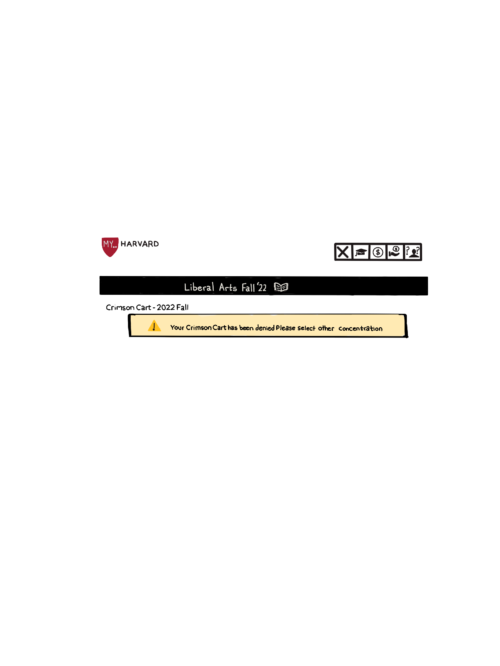Harvard breeds countless courses that students not only struggle to complete, but to even acquire spots to begin with each semester. STEM concentrations are infamous for their course exclusivity: students often must have a specific combination of prerequisites and a dash of luck in the course lottery to gain access to the golden gates of enrollment.
Yet one department that excludes numerous students for reasons other than required prior knowledge: Art, Film, and Visual Studies.
AFVS was founded on the promise of fostering both practical and critical art skills. The concentration program boasts its commitment to an “integrated study of artistic practice, visual culture, and the critical study of the image,” prioritizing a skill that most courses do not: creativity.
Students choose to enroll in AFVS courses to break the monotony of their concentration requirements or explore uncharted artistic passions. “There’s no way to self-teach yourself something like silk screening,” said Ellen Hwang ’24. “When else other than college do you get the chance?”
This fall, the department is offering 32 courses, 31 of which actively cap enrollment, and nearly half of which require prerequisite courses. As a comparison, out of the over 120 courses offered by the Psychology department, only 10 have an enrollment cap. While Psychology also features small, concentration-preferred seminars, it has large lecture courses that are more welcoming to non-concentrators, allowing anyone to get a taste for the subject in a way that is nearly impossible for AFVS, whose courses are more intimate and exclusive. “The optimal way to conduct these courses is in small groups,” reads the AFVS website.
In December of 2020, the AFVS department adopted two core values regarding the admissions process for limited enrollment classes: transparency and accessibility. Transparency requires clarity in the admissions criteria for the course on its Canvas page and syllabus, as well as treating the interview process as a casual conversation rather than an examination. Accessibility requires that professors “provide suggestions for alternate classes when a student is not admitted… and prioritize them for admission to future classes,” according to the department website. The heads of AFVS are also obligated to keep students who do not make the enrollment cut informed about AFVS resources and remain in contact with them in case of any changes.
Yet these promises have seen many instances of neglect. After not getting into multiple art courses or off their waitlists, Hwang reported not receiving any communication about other possible options or opportunities for this fall, which has altered her plans. “I thought of being an Art secondary but I probably won’t because it’s so difficult to get into courses. You need to take 6 in total, but I’ve only been able to take one because I can’t get into any others.”
This low likelihood of getting into an AFVS course as a non-concentrator often deters students from applying in the first place. Transfer student Zane Jones ’24 was intimidated by the ambiguity of the application process for production courses. She claims that if she were to take any art course, it will likely be a Gen-Ed and not a class in the AFVS department itself.
AFVS is only offering seven introductory courses this fall: two photography courses, one drawing course, and four filmmaking courses, each of which has only around a dozen open spots. AFVS 52, an introductory course for nonfiction filmmaking, had 10 available slots and 20 applicants, a demand trend which persists for most AFVS courses.
Another barrier for students wanting to explore artistic passions at Harvard is the time of many introductory AFVS courses, which, due to their practical nature, often take up to 3 hours during prime class hours. This makes it difficult for non-concentrators to fit any course into their schedule or apply for multiple courses in the hopes that they will get into one of them.
The difficulty of getting into AFVS classes extends to concentrators as well. “The application process is not centralized and there are so few spots available,” said one junior AFVS concentrator. “Different professors look for different things. Some want concentrators and some want students with less experience.” Prior to declaring their concentration sophomore year, this student had to reach out to professors months ahead of the enrollment deadline to earn priority. The student offers a simple solution: hire more professors. The demand is there.
Most AFVS instructors attempt to combat the issue by disclosing their course exclusivity on canvas and syllabus pages. Drawing 1, for example, states that “Enrollment priority will be given, respectively, to: AFVS concentrators, prospective AFVS concentrators, secondary field students, and graduate students who require a studio course.”
These high barriers to entry might be contributing to dwindling student interest in creative fields. While the Engineering and Applied Science division has seen a rise from 174 to 293 concentrators in the last ten years, the Arts and Humanities division has seen a decline from 263 to 115.
Why isn’t more funding allocated to facilitate enrollment in their courses? Perhaps it is due to the small number of concentrators, who only make up a small portion of the study body. Or perhaps the College is choosing to instead prioritize STEM fields.
One thing is clear: Now that students are giving up on exploring their artistic passions, Harvard’s commitment to intellectual curiosity and interdisciplinary learning appears to be faltering.
Kate De Groote ’25 (katedegroote@college.harvard.edu) writes Arts for the Independent.

